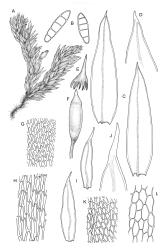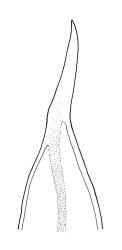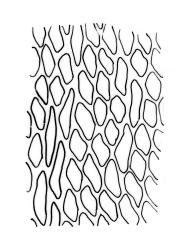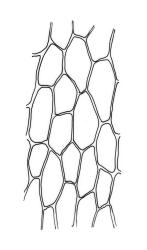- ≡ Hookeria nervosa Hook.f. & Wilson, London J. Bot. 3: 549 (1844)
- ≡ Daltonia nervosa (Hook.f. & Wilson) Hampe in Müller, Syn. Musc. Frond. 2, 17 (1850) nom. illeg., non Daltonia nervosa Hook.f. & Wilson 1842
- ≡ Bellia nervosa (Hook.f. & Wilson) Broth., Nat. Pflanzenfam. [Engler & Prantl] 1(3), 924 (1907)
- = Bellia crumii Vitt, Bryologist 74: 466 (1971)
Plants rather small, gold- to dark green, tuft-forming, epiphytic and with the habit of a Daltonia. Stems simple or branched near base, to c. 7 mm, dark brown and soft, in cross-section lacking a hyaloderm, distinct cortical layers and a central strand, sparsely beset below with smooth red-brown rhizoids. Shoots c. 2 mm wide, not complanate. Leaves erect-spreading when moist, crisped when dry, lanceolate, scarcely narrowed at base, cuspidate-acuminate and often asymmetric at apex, inserted around the stem, neither complanate nor secund, bordered throughout, narrowly recurved at both margins, (1.1–)1.3–1.9 mm; upper laminal cells firm-walled, smooth, ± mostly rounded-hexagonal and 9–12 × 4–6 µm, little altered at mid leaf; basal laminal cells larger, ± oblong-hexagonal, thinner-walled, and non-porose; border 3–5 cells and 20–25 µm wide at mid leaf, not tapered towards apex. Costa c. 30–35 µm wide in lower leaf, scarcely tapered, excurrent and fusing with the marginal borders to form a stout cusp. Propagulae apparently absent. Paraphyllia absent.
Probably dioicous. Perigonia not seen. Setae 6–7 mm, erect-flexuose, smooth below, smooth or sometimes weakly scabrous above; capsules weakly inclined, symmetric, oblong-cylindric from a tapered and strongly tuberculate neck, constricted below the mouth when dehisced and dry, c. 1.3 mm; exothecial cells ± isodiametric, strongly collenchymatous, arranged in distinct longitudinal ranks, weakly bulging (visible under stereoscope) when dry; stomata restricted to neck, superficial; operculum long-rostrate from a conic base, c. 0.6 mm. Peristome inserted at the mouth; exostome teeth pale yellow, linear-lanceolate, narrowly furrowed (furrow c. 5 µm wide), cross-striate on outer surface, the inner surface with lamellae that project laterally as stout marginal trabeculae; endostome extending c. ¾ the length of the teeth, with a basal membrane c. ⅓ the total endostomal height and biseriate and narrowly perforate segments (the segments c. twice as long as the membrane is high); cilia absent. Calyptra mitrate, laciniate-fringed at base, enclosing the entire capsule. Spores round, c. 18–27 µm, papillose.
Vitt 1977, figs. 11–20.
Sterile material of Crosbya nervosa species could very easily be confused with members of the genus Daltonia, of which only one species occurs in the N.Z. botanical region. When sterile, C. nervosa can be distinguished from Daltonia splachnoides by its smaller upper laminal cells (mostly 9–12 × 4–6 µm vs 21–36 × 6–8 µm), by leaf borders that are uniform in width throughout the leaf length, and by excurrent costae that fuse at the leaf apices with the margin borders to form stout cusps (vs borders tapered to a single row of cells near the leaf apices and costae ending below the leaf apices in D. splachnoides).
A; C.
Endemic.
Mostly on branches and trunks of Metrosideros umbellata. Also on Coprosma spp. (Vitt 1977) and Ozothamnus (Cassinia) leptophyllus and occasionally on wet rocks. Crosbya nervosa has not been recorded outside of the subantarctic islands but its eventual discovery on more exposed parts of Stewart I. seems plausible.
Sainsbury’s concept of Bellia nervosa is based primarily on material of C. straminea and differs from the concept presented both here and by Vitt (1977).
Based on peristome features, especially the ornamentation of the exostome teeth and the presence of the endostomal basal membrane, this species is treated here as congeneric with C. straminea. This accords with the published opinions of Vitt (1977). However, the relationship between Crosbya nervosa and the genus Daltonia deserves further investigation for reasons outlined above.








